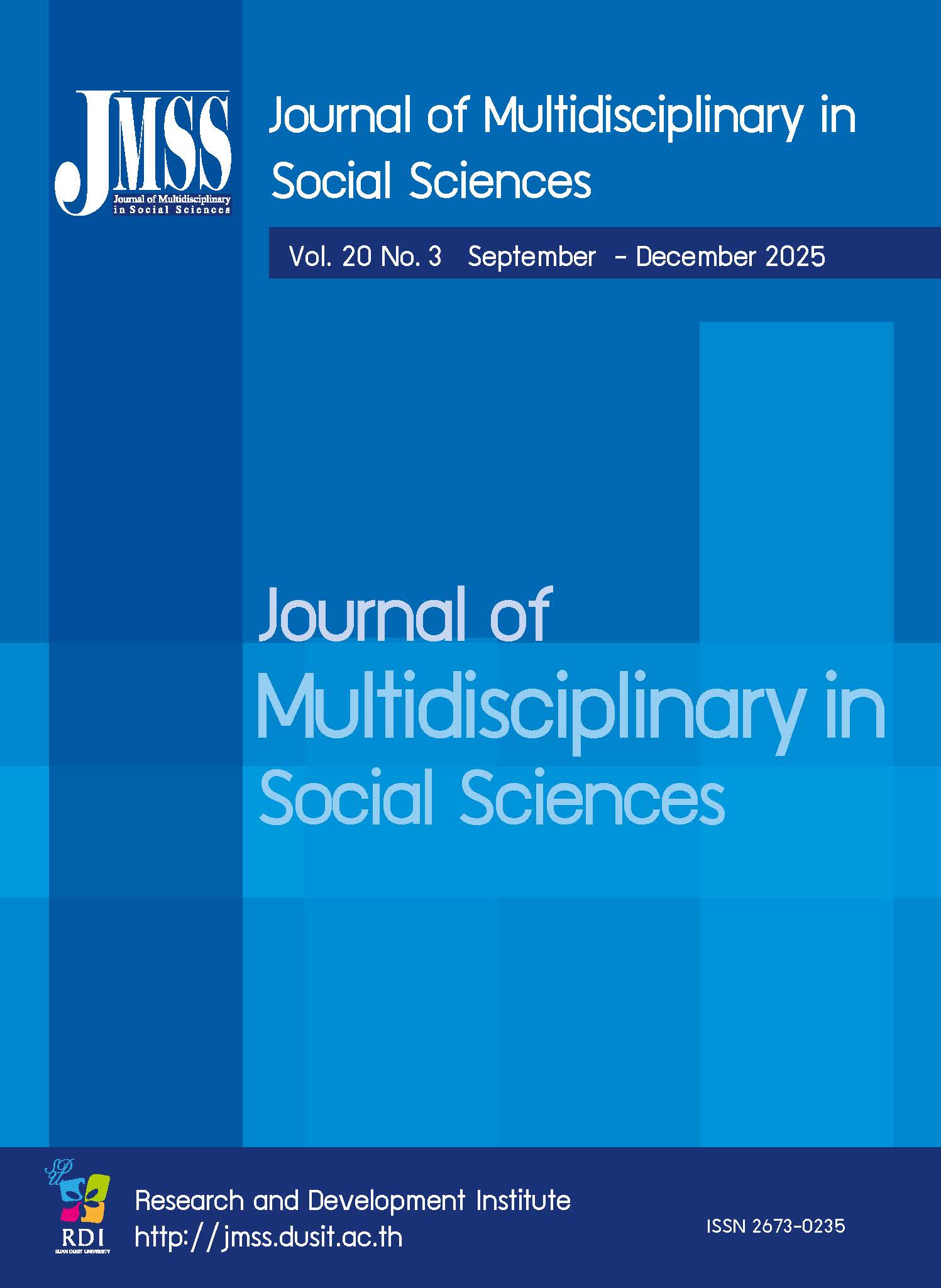Enhancing Ramtone Nokphithid Dance: Integrating Folk Performance into Tourism Activities and Community Products in Thailand
Keywords:
folk performance, tourism activity, community products, communicationAbstract
This research aimed to enhance the Ramtone Nokphithid Dance, a folk performance from Krung Ching Sub-district, Nopphitham District, Nakhon Si Thammarat Province, Thailand, dating back to World War II, by promoting it through tourism activities and community products. It also sought to evaluate tourists’ satisfaction with these activities and products, which were based on the story of the dance. This mixed-method study used Participatory Action Research (PAR) to engage the research team and local communities in enhancing the Ramtone Nokphithid Dance for publicity through tourism activities and community products. Group discussions and observations were conducted with three communities that support the Ramtone Nokphithid Dance, involving 10–12 participants from each group. Workshops were held to develop the dance’s public presence through tourism activities and products. To assess tourist satisfaction, survey research was conducted using questionnaires with 10 purposively selected participants, including representatives from relevant sectors, media, and tourists. Data were analyzed qualitatively using content analysis and quantitatively through statistical methods to describe, summarize, and compare results. The findings revealed that three communities successfully integrated the Ramtone Nokphithid Dance into tourism activities and products: (1) Ramtone Nokphithid Dance and Po Aod Tie-Dye at Krung Ching community, (2) Ramtone Nokphithid Dance Learning Center, herbal compress balls, and scented bags at Moo 2 community, and (3) Moral Community and Nokphithid keychains at Moo 6, Ban Pak Long community. These activities and products were promoted by the communities themselves and shared with tourists through community media and personal social media platforms. The evaluation of tourists’ satisfaction with the enhanced and publicized tourism activities and community products based on the Ramtone Nokphithid Dance indicated a high level of satisfaction.
References
Botoş, A., Teodorescu, N., Pârgaru, I, Stăncioiu, AF. & Radu, AC. (2013). Souvenirs – Factor influencing the tourism activity. Case study: Opinions of young people on souvenirs. Annals of the University of Petroşani, Economics,13(1), 15-34.
Chamnian, M., Chamnian, C., Mukharak, T., Boonkwan, S., Petchmon, P. & Kaew-On, S. (2020). Creation of Ramtone Nokphithid for Communicating and Promoting Community Based Tourism, Krung Ching Subdistrict, Noppitham DistrictNakhon Si Thammarat Province (Research report). Nakhon Si Thammarat: Nakhon Si Thammarat Rajabhat University.
Dychkovskyy, S. & Liashenko, L. (2020). Tourist activity of skansens in the system of intangible cultural heritage. Conservation Science in Cultural Heritage Historical-technical, 20(1), 247–263.
Hajra, V. (2015). Role of Indian folk culture in promotion of tourism in the country. Paripex-Indian Journal of Research, 4(2), 231-235.
Hiranyachawalit, S. (2016). Souvenir innovation for cultural capital. Executive Journal, 36(2), 14-23.
Hume, D. (2013). Tourism art and souvenirs: The material culture of tourism an introduction. London: Routledge.
Kaeosanit, M. & Chamnian, K. (2015). The communication approach to build teenagers’ participation and conservation on Ramtone-nokphithid in Nakhon Si Thammarat Province through using video media and online media (Research report). Nakhon Si Thammarat: Nakhon Si Thammarat Rajabhat University.
Krungching Subdistrict Administration Organization. (n.d.). History of Krung Ching Sub-district. Retrieved from https://www.krungching.go.th/history.php.
Nafasov, D. S. (2020). Cultural tourism as a factor of development of social and cultural competences of students in tourist activity. Bulletin of Pedagogical Sciences, 51, 113-115.
Paranti. L. (2018). Conservation of folk dance in the era of cultural tourism. Advances in Social Science, Education and Humanities Research, 271, 65-69.
Peng, Mi. (2024). Tourism dance in cultural tourism in Hainan Province based on the policy vision of Hainan's Free Trade Harbour Construction. International Journal of Education and Humanities, 13(3), 288-291.
Ruiz, J. G., Caicedo, B. A. & Salazar, M. (2017). Incidence of cultural activities in tourism for designing tourist products in Guayaquil. Global Business and Technology Association Changing Business Environment: Gamechangers, Opportunities and Risks, 851-858
Shahzalal, M. (2016). Positive and negative impacts of tourism on culture: A critical review of examples from the contemporary literature. Journal of Tourism, Hospitality and Sports, 20, 30-34.
Smith, M.K. (2009). Issues in Cultural Tourism Studies. London: Routledge.
Somnuxpong, S. (2020). Chiang Mai: A creative city using creative tourism management. Journal of Urban Culture Research Chiang Mai: A Creative City, 20, 122-132.
Taufatofua, L. & Tokotaha, W., H. (2002). Communicating effectively with tourists. The Open Polytechnic of New Zealand.
Yoga, G., Kharisma, P. & Pantiyasa, W. (2018). Makotek as a Tourist Attraction in Munggu Village, Bali. Advances in Economics, Business and Management Research (AEBMR), 52, 10-18.
Zhu, Q., Rahman, R., Hassan, A. & Effendi, RAARA. (2023). Souvenirs development related to cultural heritage: A thematic review. Sustainability, 15(4), 1-17.
Downloads
Published
How to Cite
Issue
Section
License
Copyright (c) 2024 Journal of Multidisciplinary in Social Sciences

This work is licensed under a Creative Commons Attribution-NonCommercial-NoDerivatives 4.0 International License.








